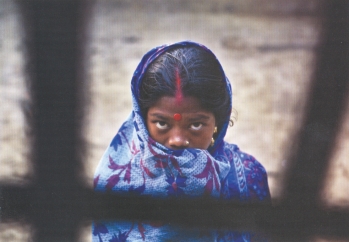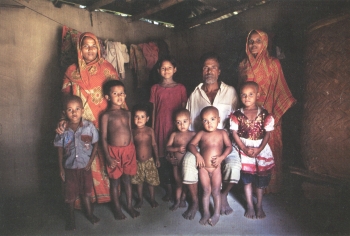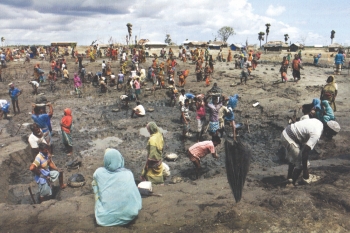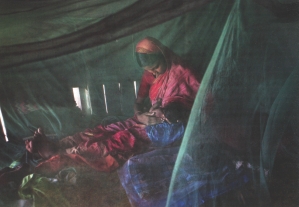| Home - Back Issues - The Team - Contact Us |
 |
| Volume 10 |Issue 41 | October 28, 2011 | |
|
|
Exhibition The Bomb that Never Explodes Sharmin Ahmed
October 21, 2011 was the inaugural ceremony of a photography exhibition organised by United Nation Population Fund (UNFPA): 'Bangladesh in a World of 7 Billion' by Naymuzzaman Prince at La Galerie, Alliance Francaise de Dhaka. It was themed on a very serious issue 'Population', a problem that is of urgent concern in Bangladesh and in the world. Prince who is a documentary photographer presented images of the people of Bangladesh, showing daily life and challenges in different areas of the highly populated country. According to the estimates of the United Nations Population Division, on October 31, 2011 the world's population will reach 7 billion people. Says Arthur Erken, UNFPA representative of Bangladesh, “This global milestone presents a challenge, an opportunity, as well as an urgent call to action. Wether we can live together on a healthy and prosperous planet will depend on the choices we make today. However it is also true that we have the unprecedented capacity to share information and ideas and engage communities across the globe to solve the problems that affect us all. And with that awareness in mind the exhibition which is part of the United Nations 7 Billion Actions Campaign to raise awareness.”
The pictures were a graphic presentation of the various root-causes of the population explosion such as adolescent marriages which result in high fertility. Unequal gender relations persist in denying girls and women of their reproductive rights, with little bargaining power and decision making regarding their marriage, fertility and access to treatment. This is also economically true in the sense that despite giving the same amount of labour hours, females are subjected to lower wages then their male counterparts. Bangladesh is the 7th most populous nation in the world, as small as it is the population is expected to grow to 194 million by 2050! This is a very alarming prospect even though Bangladesh has been quite successful in its population growth rate reduction from 6.2 percent to 3.2, thanks to its vigorous family planning programme since the 1970s. A World Bank study in 1993 concluded that Bangladesh, alone among the world's 20 poorest countries, had achieved a significant, sustained decline in birth rates from 7 to 4.5 due mostly to the Government established national family planning programme this needs to be maintained.
Bangladesh still needs a more sustainable and stringent policy for population or else it will add greatly to the already existing 'Decade for Food-crisis'. "As it is in a developing country, Bangladesh is prone to growing population rates and will eventually become saturated" states Muaz Jalil, a development practitioner at a multi-donor funded project "with increase in prosperity population growth may stabilise as economic growth and population growth have an inverse relation. However this increase in purchasing power will result in greater demand for food and hence rise in food prices as demand cannot be met in supply. This might contribute to rising food crisis.” From a broader view, population is a multi-dimensional problem, most developed economies in their time of economic boom required labour hence vast amounts of migrant labour moved to Europe and other developed regions of the world, especially places like the UK, the Asian sub-continent and Africa - such as the move of many Algerians to France. Those who have migrated enjoyed better economic progress; however this resulted in the fall of growth in the indigenous population and created cultural tensions often resulting in hate crimes. One such case we witnessed not so long ago in Norway on the Island of Utoya. Anders Behring, a rightist who felt his ethnic race threatened and in danger of extinction due to cross cultural changes and growth went on a murderous rampage. So cultural implications will also increase with the growth rate of population, particularly, if the issue of differential birthrates is considered which leads to changes in demography that are not desirable and thereby result in integration issues. As admitted by German Chancellor Angela Merkel, attempts to build a multi-cultural society in Germany had utterly failed; population integration has not worked out.
It is quite obvious that there are serious ramifications to the population escalation as an agenda. But the scary part is that it is an ever emergent problem of growth and that it is capricious in nature. Michael Crichton at the Caltech Michelin Lecture in January 17, 2003 stated: "In 1960, Paul Ehrlich said, 'the battle to feed humanity is over. In the 1970s the world will undergo famines-hundreds of millions of people are going to starve to death'. Ten years later, he predicted four billion people would die during the 1980s, including 65 million Americans.’ The mass starvation that was predicted never occurred, and it now seems it isn't ever going to happen. Nor is the population explosion going to reach the numbers predicted even ten years ago. In 1990, climate modelers anticipated a world population of 11 billion by 2100. Today, some people think the correct number will be 7 billion and falling. But nobody knows for sure”. It is a fact that many countries are facing zero growth or declining growth rates; often these being skewed towards the indigenous population of various nations of various economic profiles. What turn the growth takes is not as predictable as it appears, thus one may come to the conclusion that population is not a time bomb waiting to explode; it is a slow but growing cancer, to which the old adage may be applied – prevention is better, or maybe even more feasible, than cure.
Copyright
(R) thedailystar.net 2011 |
||||||||



